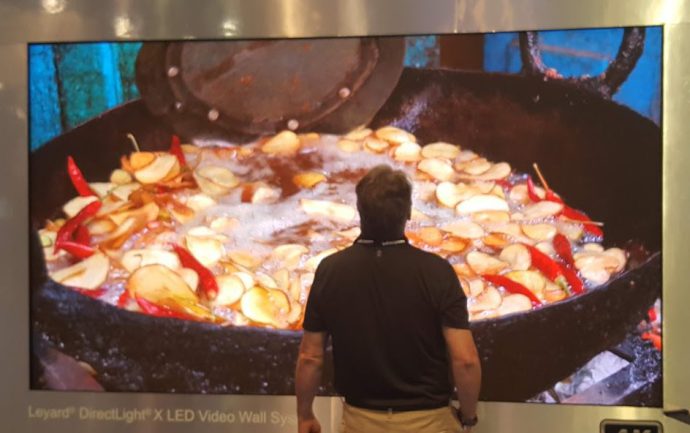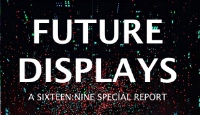
LED Display Market Now Valued At More Than $5B: Futuresource
August 16, 2018 by Dave Haynes
LED displays are now a $5 billion global market, with the Americas region reaching a key milestone of $1 billion for the first time in 2017.
The data comes from the market research firm Futuresource Consulting, which makes displays one of a relatively short list of vertical markets it studies. I note this because news searches on digital signage and displays are cluttered with pricey but mostly worthless reports from Indian research factories that produce encouraging reports on absolutely anything they can dream up.
“The introduction of MicroLED by Sony in 2016 caused a great stir of excitement in the industry, but it was thought to be a measure of what was possible, not what was viable in the near term,” says Chris McIntyre-Brown, Associate Director at Futuresource Consulting. “However, this year has seen far more buzz around new chip-on-boards (COB) solutions, MiniLED and glue-on-board. All offer different benefits, but it is really the potential of MiniLED that has the industry excited. Troublingly though, are the lack of standards around MiniLED, MicroLED and indeed the LED industry as a whole. This is creating confusion – and that certainly needs to be addressed.”
1000 percent agreed there. As someone trying to watch this emerging market, trying to put a finger on what really is micro LED, mini LED and so on is very, very tough.
I’ve not seen the report ($$$$) but a press release says it goes into the competitive landscape, which is very cluttered but as with most emerging businesses, sees consolidation: The LED market has also witnessed strong merger and acquisition activity in recent years, with display vendors looking to access new technologies, increase their geographical footprint or diversify their customer bases. Futuresource expects to see this activity continue in the coming years as the market matures.
“An area to watch will be the new entrants launching LED products, typically coming from other areas of the visual display market. Indeed, it is increasingly rare to find a professional display vendor without LED in its range – although there are still a number of heavyweights in adjacent display areas yet to enter,” adds McIntyre-Brown.
Futuresource also expects service, support and localization to become more important with established international display brands expected to grow in stature.
That’s a polite way of saying integrators and end-users have had the painful experience and now know they don’t want to deal with 12-hour time zone differences and equally yawning language gaps between North America and China.
Futuresource expects big growth in LED through at least 2022. It is now almost impossible to find a vertical market or end application where LED displays haven’t been optimized for both indoor and outdoor applications and this is for good reason. “The industry is poised to take the next step in technological advancement and with that we see the LED display community beginning to wonder just how much share it can take from the giant that is the LCD industry.”
Futuresource says, in a separate report, that narrow pixel pitch LED sales grew by 50% last year to reach $1.7 billion – equating to a visual surface area of 148,000 square metres. “This product saw huge technological advances, with Flip Chip, Chip-on-Board, Micro and Mini LED all becoming available on new products and creating new opportunities where those products could be used,” says market analyst Graham Cooke.
Futuresource defines the Narrow Pixel Pitch market as 3mm and below. The “race to the bottom” for pixel pitches has not been happening as quickly as before, with the P1.2 – 1.5mm range being considered the sweet spot in this space now. Sub P1mm is still seen as having technological difficulties the industry has yet to overcome. For most applications P1.2 – 1.5mm is good enough, and in fact many users simply require a P1.something mm for the content they are showing. NPP LED accounts for nearly 40% of all LED value (all pixel pitches) in 2017, a gain of 5 percentage points on the year previous.
For the market above NPP LED, the trend to smaller pixel pitches has been seen, with areas such as retail, traditionally an area installing P5mm, now installing P3.9mm product for many of the volume sectors.
In more premium retailers or designer shops, NPP LED is being used – P2.5mm for example behind cashiers. In some technology flag ship stores, sub 2mm is being utilized.
Cooke notes there is a shift towards a wider global market: “Products are starting to trickle down from the more premium categories, and this movement into more every-day space will encourage the market to move to the next level.”
The report evidently pegs Leyard as the biggest LED display company out there. The Chinese company, which has a strong US presence through its acquisition of Planar, issued a separate press release off the back of the report, saying:
Leyard earned the No. 1 market share position in the $4.5 billion LED video display market, and the No. 1 position in the fastest growing $1.6 billion narrow pixel pitch LED video wall segment, according to two reports by Futuresource Consulting. The analyses, which compared the 2017 performance of all major video wall brands, confirmed Leyard’s No. 1 position, in addition to the company’s increasing share and growth in the highly competitive market.
Leyard was the market share leader in the narrow pixel pitch LED video display market in 2017, following years of leadership and share dominance in this category, which the company pioneered. Leyard also captured the top position in the broader LED display market that includes all pixel pitch sizes, including indoor and outdoor products, covering a wide range of applications and customer segments.



Leave a comment